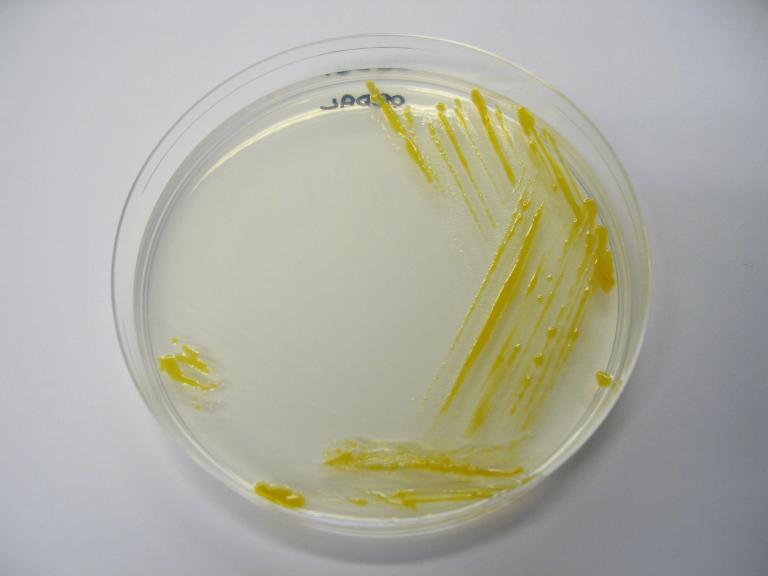
Systemic infection with F. psychrophilum in rainbow trout is a notifiable disease in Norway (category F), and any suspicion or detection must be reported immediately to the Norwegian Food Safety Authority (Mattilsynet).
Pathogen and Transmission
Flavobacterium psychrophilum belongs to the bacterial genus Flavobacterium, which includes yellow-pigmented, elongated, gliding rod-shaped bacteria. The ability to cause disease varies between different bacterial strains and depends on the susceptibility of the host. During disease outbreaks in Atlantic salmon and brown trout, a wide diversity of bacterial strains have been associated with diseased fish.
During outbreaks, the bacterium is transmitted horizontally from fish to fish. Under Norwegian conditions, it is assumed that the bacterium can also spread between fish in the upper layers of seawater where salinity is low.
Vertical transmission from broodstock to offspring cannot be ruled out, as the bacterium has been detected in both male and female reproductive products. Experimental studies have shown that colonization of eyed eggs by the bacterium can lead to disease in fry. Moreover, in several countries and geographic regions, closely related strains of F. psychrophilum have been associated with disease outbreaks in rainbow trout. The epidemiological patterns observed during outbreaks further support this mode of transmission.
The bacterium also has the ability to form biofilms, which enhances its ability to persist in the environment over extended periods.
Occurrence
F. psychrophilum is primarily associated with disease in freshwater salmonids but has also been detected in other fish species. Among salmonids, rainbow trout (Oncorhynchus mykiss) and coho salmon (Oncorhynchus kisutch) are considered particularly susceptible.
In Norway, disease problems associated with this bacterium have varied from year to year. In 2008, a localized but severe outbreak with high mortality occurred in rainbow trout at several freshwater hatcheries. In recent years, detections in rainbow trout during the hatchery phase have been infrequent. However, the disease now appears to have established itself in rainbow trout following sea transfer in a fjord system in western Norway.
The bacterium is regularly isolated from trout (Salmo trutta) and Atlantic salmon (Salmo salar) in both enhancement hatcheries and commercial freshwater hatcheries, typically in association with skin ulcers and fin rot. Systemic infections (involving internal organs) have also been detected in Atlantic salmon at some hatchery sites during winter.
F. psychrophilum was first isolated from diseased coho salmon in the United States in 1960, although the disease was described as early as 1946. The infection emerged on the European continent in rainbow trout in the mid-1980s and is now regarded as one of the most significant global challenges in rainbow trout production. In addition, disease in ayu (Plecoglossus altivelis) has been identified as a significant issue in Japanese aquaculture.
Clinical Signs
Diseases caused by F. psychrophilum include Bacterial Cold Water Disease (BCWD) and Rainbow Trout Fry Syndrome (RTFS).
In rainbow trout fry, symptoms include poor appetite, spiral swimming, surface swimming, and occasionally short convulsions before death. Affected fish may appear dark at first, later becoming pale due to anemia or edema. A swollen abdomen is typical, and the spleen may be visible through the abdominal wall as a red spot. “Helicopter tails” have been reported in populations that experienced clinical RTFS outbreaks in Norway.
In larger fish, external lesions are more common: hemorrhagic abscesses, ulcers, and fin rot. Ascites and anemia are also frequently observed.
Diagnosis
At the Norwegian Veterinary Institute, diagnosis of the disease is based on case history, pathological findings, and microbiological investigations. Confirmation of the diagnosis requires isolation and identification of the bacterium.
Suspicion is raised and the diagnosis supported by the presence of characteristic microscopic tissue changes (histopathology), detection of bacterial antigens in tissue using immunological methods (immunohistochemistry), and/or positive PCR results.
In rainbow trout typical findings include necrosis and congestion in the spleen. The splenic capsule may be replaced by an eosinophilic layer and/or granulation tissue. The fish may show pericarditis and myocarditis with varying infiltration of polymorphonuclear leukocytes. Long, slender bacteria are frequently observed in association with pathological changes.
F. psychrophilum is a strictly aerobic, yellow-pigmented, Gram-negative, long filamentous bacterium that grows on specialized media after 2-5 days. Commonly used media include Anacker and Ordal, KDM, and TYES. Identification of the bacterium is based on phenotypic characteristics and confirmed by mass spectrometry (MALDI-TOF MS) and/or DNA sequencing. A quantitative molecular method (real-time PCR) has also been established at the Veterinary Institute.
Genotyping of F. psychrophilum at the Veterinary Institute is commonly performed using MLST (multilocus sequence typing).
Control Measures
Systemic infection with F. psychrophilum in rainbow trout is a notifiable disease in Norway (Category F).
Vaccination of fry has so far not yielded satisfactory results. However, both mono- and multivalent injectable vaccines have been reported to offer protection in larger fish. A combination vaccine containing Flavobacterium psychrophilum is available on the Norwegian market.
Suboptimal environmental conditions and stress are likely triggers for disease outbreaks.
The disease can be managed through hygiene measures, and medical treatment may be necessary. Internationally, the development of resistance to commonly used antibacterial agents is an increasing concern. F. psychrophilum strains isolated from rainbow trout in Norway have shown reduced sensitivity to quinolones. Relapses in previously treated fish groups are not uncommon.
The bacterium is susceptible to commonly used disinfectants, and strict hygiene and effective disinfection protocols are essential to prevent vertical transmission from broodstock to offspring via reproductive material. Disinfection of eggs is mandatory, and iodophores are commonly used for this purpose.
